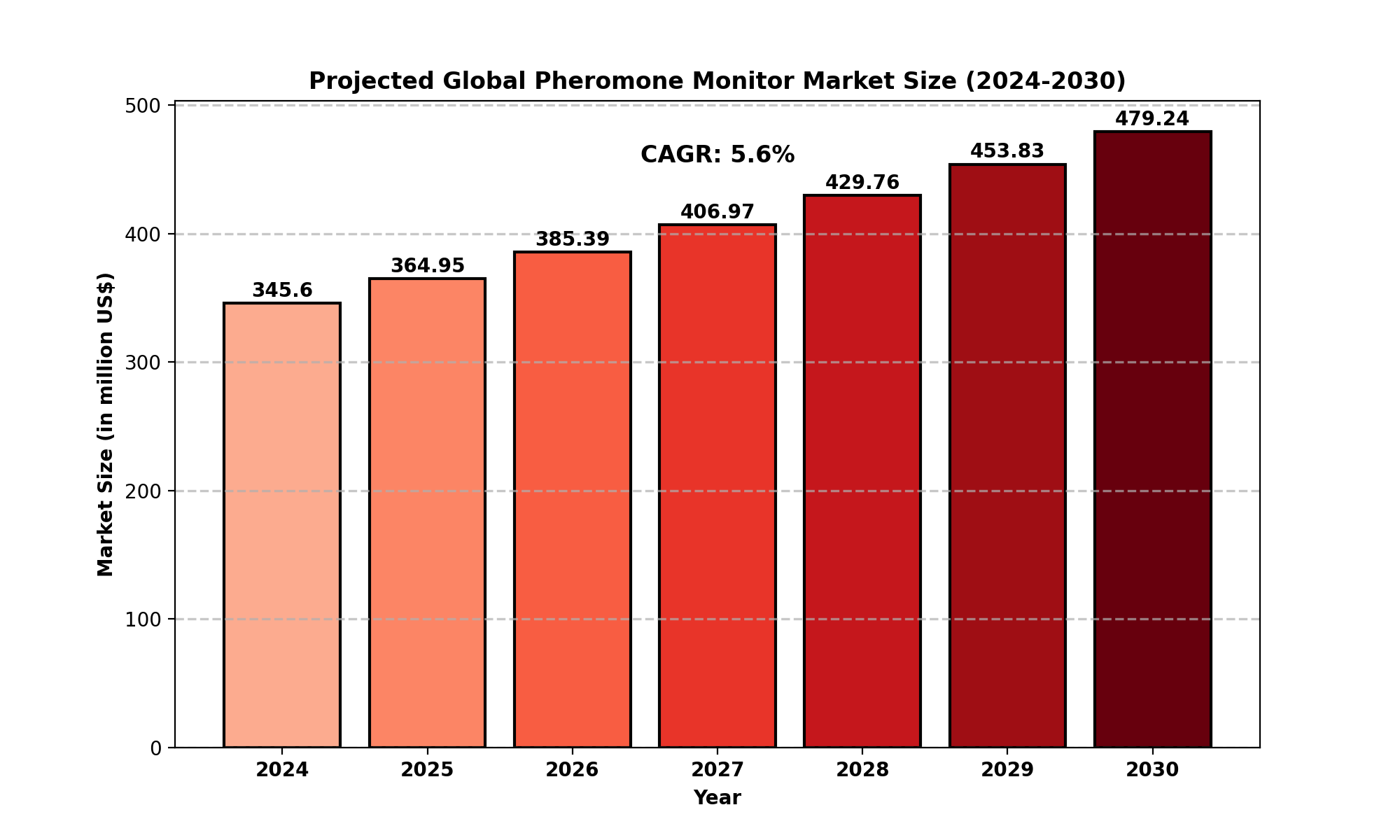TOP CATEGORY: Chemicals & Materials | Life Sciences | Banking & Finance | ICT Media

Download Report PDF Instantly
Report overview
The global Pheromone Monitor market involves devices designed to monitor insect pheromone levels and detect pest activity in agricultural settings. These devices utilize pheromones, chemical signals emitted by insects, to lure and trap them, providing real-time data on pest populations. The key products in this market include various types of traps and monitoring systems that help farmers, pest control professionals, and researchers monitor pest activity, specifically targeting insects that impact crop yields.
Pheromone monitoring plays a significant role in integrated pest management (IPM) systems, which are designed to minimize the use of chemical pesticides and reduce environmental impact. By using pheromones to track pests, these devices offer a more eco-friendly and sustainable approach to pest control.
Market Size
The global Pheromone Monitor market was valued at USD 345.6 million in 2024 and is expected to grow significantly, with projections reaching USD 479.2 million by 2030, at a compound annual growth rate (CAGR) of 5.6% during the forecast period of 2024-2030. This growth is driven by the increasing adoption of integrated pest management (IPM) strategies, which prioritize sustainable and eco-friendly pest control methods.
The market is also experiencing a shift towards more accurate and efficient monitoring devices, which are essential in pest detection and management. With growing concerns over the environmental impact of chemical pesticides, pheromone monitors are becoming a preferred solution in many agricultural sectors worldwide.

Market Dynamics (Drivers, Restraints, Opportunities, and Challenges)
Drivers
Sustainability and Eco-Friendly Practices: The increasing demand for eco-friendly pest control methods is one of the primary drivers for the market. Pheromone monitors support integrated pest management (IPM), reducing reliance on chemical pesticides and contributing to sustainable agricultural practices.
Technological Advancements: Innovation in pheromone monitoring devices, such as enhanced accuracy, longer operational life, and more efficient designs, has driven market expansion.
Rising Global Agriculture Demand: As the global population grows, the demand for increased agricultural productivity intensifies. Farmers seek more effective ways to protect crops, driving the need for advanced pest detection and management systems.
Restraints
High Initial Investment: The upfront cost of implementing pheromone monitoring systems can be a barrier for smaller farmers, particularly in developing regions.
Technical Expertise: Proper installation and operation of pheromone monitors require a certain level of expertise, which may limit adoption in some regions.
Limited Awareness: In some parts of the world, particularly in developing countries, there is limited awareness about the benefits of pheromone monitoring, hindering market growth.
Opportunities
Expanding Agricultural Markets: As emerging economies invest in modern agricultural technologies, the potential for pheromone monitor adoption increases.
Development of More Accurate and Cost-Effective Devices: Manufacturers have the opportunity to innovate and develop pheromone monitors that are not only more accurate but also more affordable, making them accessible to a wider range of agricultural producers.
Government Support and Regulations: Many governments worldwide are promoting sustainable agricultural practices, creating a favorable regulatory environment for the adoption of eco-friendly pest control methods.
Challenges
Pest Resistance: Over-reliance on pheromone-based monitoring can lead to resistance in certain pest species, potentially reducing the effectiveness of this method.
Environmental and Climate Factors: Adverse weather conditions can impact the performance of pheromone traps, which rely on specific environmental factors to function optimally.
Regional Analysis
North America
The United States dominates the North American Pheromone Monitor market, with a projected market size of USD 98.4 million in 2024, expected to reach USD 134.5 million by 2030. The region's advanced agricultural infrastructure, adoption of sustainable farming practices, and government support for eco-friendly pest control solutions contribute to the growth of the market.
Europe
Europe is another key market for pheromone monitors, with significant demand driven by the agricultural sector in countries like Germany, the UK, and France. The region's emphasis on sustainable agricultural practices and reducing chemical pesticide use supports market expansion.
Asia-Pacific
The Asia-Pacific region, especially China and India, represents a rapidly growing market due to the large agricultural sectors in these countries. Increasing awareness of integrated pest management techniques and rising agricultural productivity requirements are driving the adoption of pheromone monitoring systems.
South America
In South America, countries like Brazil and Argentina are expected to see growth in pheromone monitor usage, driven by their extensive agricultural production and increasing need for effective pest control solutions.
Middle East and Africa
The Middle East and Africa represent a smaller portion of the market, but as agricultural techniques advance in countries like Saudi Arabia and Egypt, demand for pest monitoring systems is on the rise.
Competitor Analysis
Key players in the global Pheromone Monitor market include:
Shin-Etsu
BASF
Suterra
Biobest Group
Isagro
Bedoukian Research
Hercon Environmental
Koppert Biological Systems
Pherobio Technology
Russell IPM
These companies are engaged in research and development to improve pheromone-based pest control products. They focus on technological innovation, product expansion, and strategic partnerships to strengthen their positions in the market. Key strategies involve diversifying product offerings, entering emerging markets, and offering customized solutions for different agricultural sectors.
Global Pheromone Monitor: Market Segmentation Analysis
This report provides a deep insight into the global Pheromone Monitor market, covering all its essential aspects. This ranges from a macro overview of the market to micro details of the market size, competitive landscape, development trends, niche market, key market drivers, and challenges, SWOT analysis, value chain analysis, etc.
The analysis helps the reader to shape the competition within the industries and strategies for the competitive environment to enhance the potential profit. Furthermore, it provides a simple framework for evaluating and assessing the position of the business organization. The report structure also focuses on the competitive landscape of the Global Pheromone Monitor Market, this report introduces in detail the market share, market performance, product situation, operation situation, etc., of the main players, which helps the readers in the industry to identify the main competitors and deeply understand the competition pattern of the market.
In a word, this report is a must-read for industry players, investors, researchers, consultants, business strategists, and all those who have any kind of stake or are planning to foray into the Pheromone Monitor market in any manner.
Market Segmentation (by Application)
Fruits and Vegetables
Field Crops
Market Segmentation (by Type)
Bottle Trap
Funnel Trap
Delta Trap
Others
Key Company
Shin-Etsu
BASF
Suterra
Biobest Group
Isagro
Bedoukian Research
Hercon Environmental
Koppert Biological Systems
Pherobio Technology
Russell IPM
SEDQ Healthy Crops
Certis Europe
Agrobio
Jiangsu Wanhe Daye
ISCA
Scentry Biologicals
Geographic Segmentation
North America (USA, Canada, Mexico)
Europe (Germany, UK, France, Russia, Italy, Rest of Europe)
Asia-Pacific (China, Japan, South Korea, India, Southeast Asia, Rest of Asia-Pacific)
South America (Brazil, Argentina, Columbia, Rest of South America)
The Middle East and Africa (Saudi Arabia, UAE, Egypt, Nigeria, South Africa, Rest of MEA)
FAQ Section
What is the current market size of the Pheromone Monitor market?
Which are the key companies operating in the Pheromone Monitor market?
What are the key growth drivers in the Pheromone Monitor market?
Which regions dominate the Pheromone Monitor market?
What are the emerging trends in the Pheromone Monitor market?
Key Benefits of This Market Research:
Key Reasons to Buy this Report: